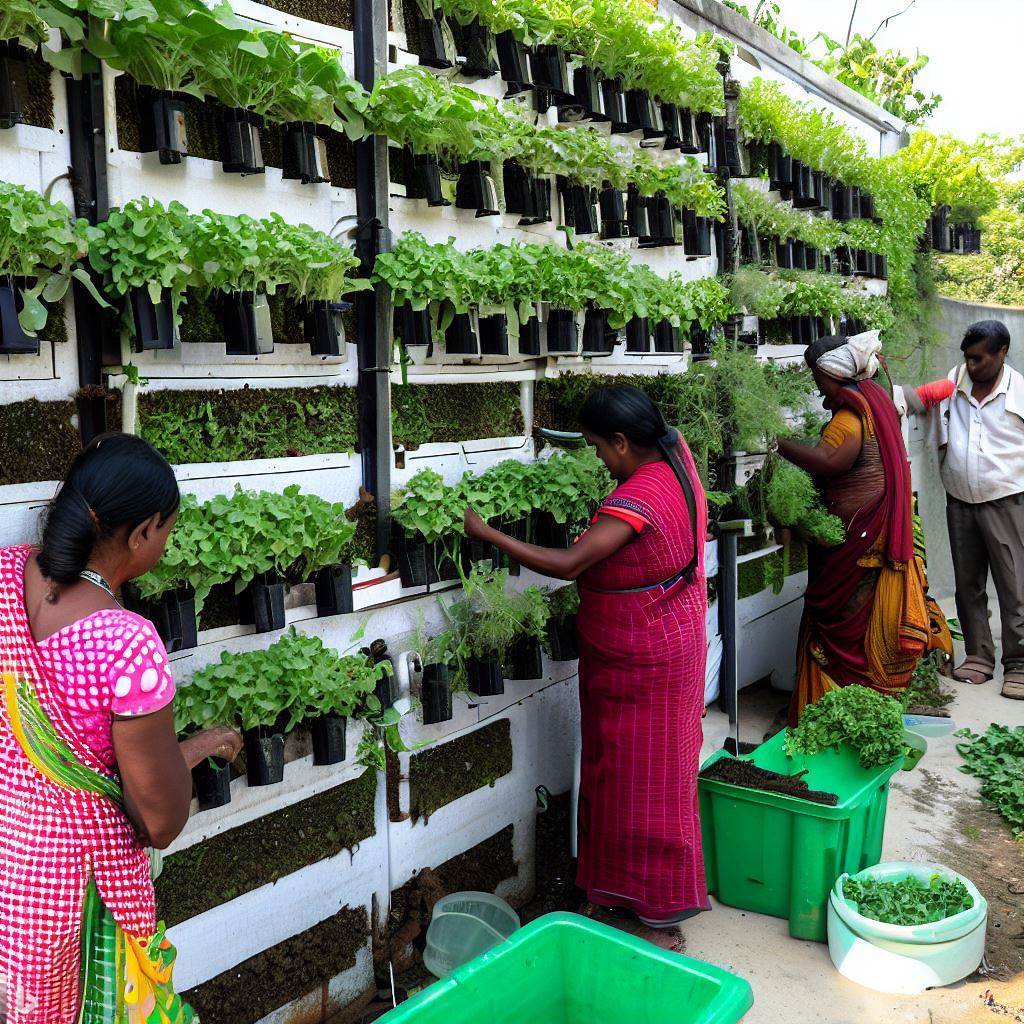Vertical farming is a revolutionary agricultural technique that has been gaining popularity in India in recent years. This innovative method of growing crops involves stacking layers of plants in a controlled environment, such as a warehouse or greenhouse, with precise control over light, temperature, and nutrients. In this article, we will discuss everything you need to know about vertical farming in India, including business plans, crops, subsidies, companies, costs, and profits.
Business Plan for Vertical Farming in India
Starting a vertical farm in India requires careful planning and research to ensure its success. To create a successful business plan, entrepreneurs should consider the following aspects:
- Plan and research
Before starting vertical farming, it’s essential to plan and research the market demand, crop selection, and operational costs. Identify the potential market for your crops, and research the types of crops that have high demand and can be grown efficiently using vertical farming techniques.
- Choose a suitable location
Choose a suitable location that provides access to electricity, water, and other essential resources required for vertical farming. The location should also have adequate space and accessibility for the delivery and transportation of crops.
- Decide on the vertical farming system
There are several types of vertical farming systems available in India, such as hydroponics, aeroponics, and aquaponics. Each system has its advantages and disadvantages, and you should select a system that suits your crop selection and available resources.
- Set up the infrastructure
Set up the infrastructure required for vertical farming, such as shelves, lighting, irrigation systems, and ventilation. It’s essential to ensure that the infrastructure is designed efficiently to maximize space, light, and water use.

- Choose suitable crops
Select suitable crops that can be grown efficiently in a controlled environment. Some examples of crops that can be grown using vertical farming techniques in India include leafy greens, herbs, strawberries, and tomatoes.
- Implement efficient resource use
Efficient resource use is crucial for the success of vertical farming in India. This includes using renewable energy sources, such as solar panels, and recycling water to reduce operational costs and environmental impact.
- Monitor and maintain the system
Regular monitoring and maintenance are essential to ensure the system operates efficiently and provides optimal crop yields. This includes monitoring water and nutrient levels, controlling pests and diseases, and ensuring proper ventilation and lighting.
Starting a vertical farming system in India requires careful planning, efficient resource use, and suitable crop selection. With the right approach, vertical farming can provide a profitable and sustainable solution to increase crop yields, efficient resource use, and local food production.
- Obtain necessary permits and licenses
Obtain necessary permits and licenses from local authorities before starting vertical farming. In India, some states have specific regulations and requirements for vertical farming, such as licenses for using water and electricity. It’s essential to ensure that your vertical farming system complies with all the necessary regulations and requirements.
- Market your produce
Marketing your produce is essential to the success of your vertical farming business. Identify potential buyers, such as restaurants, grocery stores, and individuals interested in local produce. Social media and online marketplaces can also be useful for marketing and selling your crops.
- Continuously innovate and improve
Vertical farming is an ever-evolving technique that requires continuous innovation and improvement. Stay up-to-date with the latest research and developments in the field and implement new technologies and techniques to optimize your vertical farming system.
Starting a successful vertical farming system in India requires careful planning, efficient resource use, and suitable crop selection. By following these steps, you can set up a profitable and sustainable agricultural business that can help increase crop yields, efficient resource use, and local food production.
Crops for Vertical Farming in India
Vertical farming is suitable for growing a wide range of crops, including fruits, vegetables, herbs, and flowers. However, some crops are more popular in India than others, such as:
- Leafy vegetables: Spinach, lettuce, kale, arugula, and other leafy greens are excellent candidates for vertical farming. They are fast-growing, require less space, and can be harvested in just a few weeks.
- Herbs: Basil, mint, cilantro, parsley, and other herbs can also be grown in vertical farms. They require less water and can be harvested multiple times.
- Strawberries: Strawberries can be grown in vertical farming and have the potential for high yields. They also have a shorter growing season, making them a suitable crop for India’s climate.
- Tomatoes: Tomatoes are a popular crop in India and can be grown in vertical farming. They require a support system to grow, which can be easily provided in a vertical farm.
- Cucumbers: Cucumbers are another crop that can be grown vertically. They require less space and are easier to harvest when grown in a vertical farm.

Subsidies for Vertical Farming in India
The Indian government provides several subsidies and schemes to support the growth of vertical farming in the country. Some of the popular subsidies include:
- National Horticulture Mission: The National Horticulture Mission provides financial assistance for setting up new horticulture farms, including vertical farms.
- National Agricultural Development Program: The National Agricultural Development Program provides financial assistance for the development of agricultural infrastructure, including vertical farms.
- Agricultural Credit Scheme: The Agricultural Credit Scheme provides loans to farmers and entrepreneurs for the development of agricultural infrastructure, including vertical farms.
Companies Offering Vertical Farming Solutions in India
Several companies are offering vertical farming solutions in India. Here are some of the most popular ones:
- UrbanKisaan: UrbanKisaan is an Indian company that offers vertical farming solutions for homes, offices, and commercial spaces. They specialize in growing microgreens and herbs on vertical farms.
- Infarm: Infarm is a German company that offers vertical farming solutions in India. They specialize in modular vertical farms that can be customized based on the client’s requirements.
- Agrify: Agrify is an American company that offers vertical farming solutions in India. They specialize in growing strawberries in vertical farms using LED lighting and an innovative cooling system.
- Sky Greens: Sky Greens is a Singapore-based company that offers vertical farming solutions in India. They specialize in using a patented hydraulic system to grow vegetables vertically.
- Vertical Greens: Vertical Greens is an Indian company that offers vertical farming solutions in India. They specialize in modular vertical farms that can be customized based on the client’s requirements and offer services for a range of crops such as lettuce, basil, mint, and spinach.
Cost and Profitability of Vertical Farming in India
The cost and profitability of vertical farming in India depend on various factors such as location, crop selection, infrastructure, and market demand. Here are some of the expenses involved in starting a vertical farm in India:
- Infrastructure: Building and setting up a vertical farm in India can cost anywhere between INR 5 lakh to INR 1 crore, depending on the size and complexity of the project.
- Equipment and Technology: The cost of equipment and technology required for vertical farming, such as LED lights, hydroponic systems, and temperature control systems, can range from INR 1 lakh to INR 50 lakh.
- Labor: The cost of labor involved in planting, harvesting, and maintaining the crops can vary depending on the size of the vertical farm.
- Marketing and Sales: Entrepreneurs need to invest in marketing and sales strategies to reach potential customers and achieve profitability.
Despite the high initial investment, vertical farming in India can be profitable in the long run. Vertical farms can produce higher yields than traditional farms, require less land and water, and are less susceptible to pests and diseases. Some of the factors that can affect the profitability of vertical farming in India include market demand, pricing strategy, and operational efficiency.
Benefits of Vertical Farming in India
- High Yield: Vertical farming can produce higher yields than traditional farming methods, as crops can be grown in multiple layers, stacked vertically. This method can increase crop yield by up to 10 times compared to traditional farming.
- Controlled Environment: The environment in a vertical farm can be carefully controlled, allowing for optimal growing conditions. Temperature, humidity, light, and nutrients can all be precisely regulated to ensure the best growth conditions for the crops.
- Efficient Resource Use: Vertical farming uses significantly less land, water, and pesticides than traditional farming methods. This technique also eliminates the need for soil, which can be a scarce resource in some parts of India.
- Year-Round Production: Vertical farming allows for year-round crop production, regardless of weather conditions. This feature is especially beneficial for regions with extreme weather conditions, where traditional farming may not be possible.
- Local Food Production: Vertical farming can be used to produce fresh, healthy, and locally-grown food for urban areas, reducing the need for long-distance transportation of food.
Disadvantages of Vertical Farming in India
- High Initial Investment: Vertical farming requires a significant initial investment in infrastructure, equipment, and technology. This cost can be a barrier for entrepreneurs looking to start a vertical farm in India.
- Energy Use: Vertical farming requires a lot of energy to power the artificial lighting and temperature control systems. This energy consumption can lead to high electricity bills, which can reduce profitability.
- Limited Crop Selection: Not all crops can be grown using vertical farming techniques. The crops that can be grown in a vertical farm are limited to leafy greens, herbs, and some fruits.
- Technical Expertise: Vertical farming requires technical expertise and specialized knowledge in areas such as lighting, hydroponics, and climate control. This expertise may not be easily available in all regions of India.

- Maintenance Costs: Vertical farms require regular maintenance to ensure optimal crop growth conditions. This maintenance can be costly, and failure to maintain the systems can lead to crop failure.
Conclusion
Vertical farming is an innovative and sustainable agricultural technique that is gaining popularity in India. Entrepreneurs looking to start a vertical farm in India should consider various factors such as market demand, legal requirements, infrastructure, and profitability before starting the business. Vertical farming in India offers a promising future, with the government providing several subsidies and schemes to support the growth of the industry. With careful planning, research, and execution, vertical farming can be a profitable and sustainable business in India.
Starting a Vertical farming business in India can be challenging, but with the right skills, knowledge, and support, you can build a highly productive garden in your small space. At ffreedom app, we offer a variety of Farming courses to help you succeed.
Our courses are designed to give you practical knowledge and skills that you can apply directly to your garden. Taught by experienced industry professionals, our courses cater to beginners and experienced farming owners alike.





